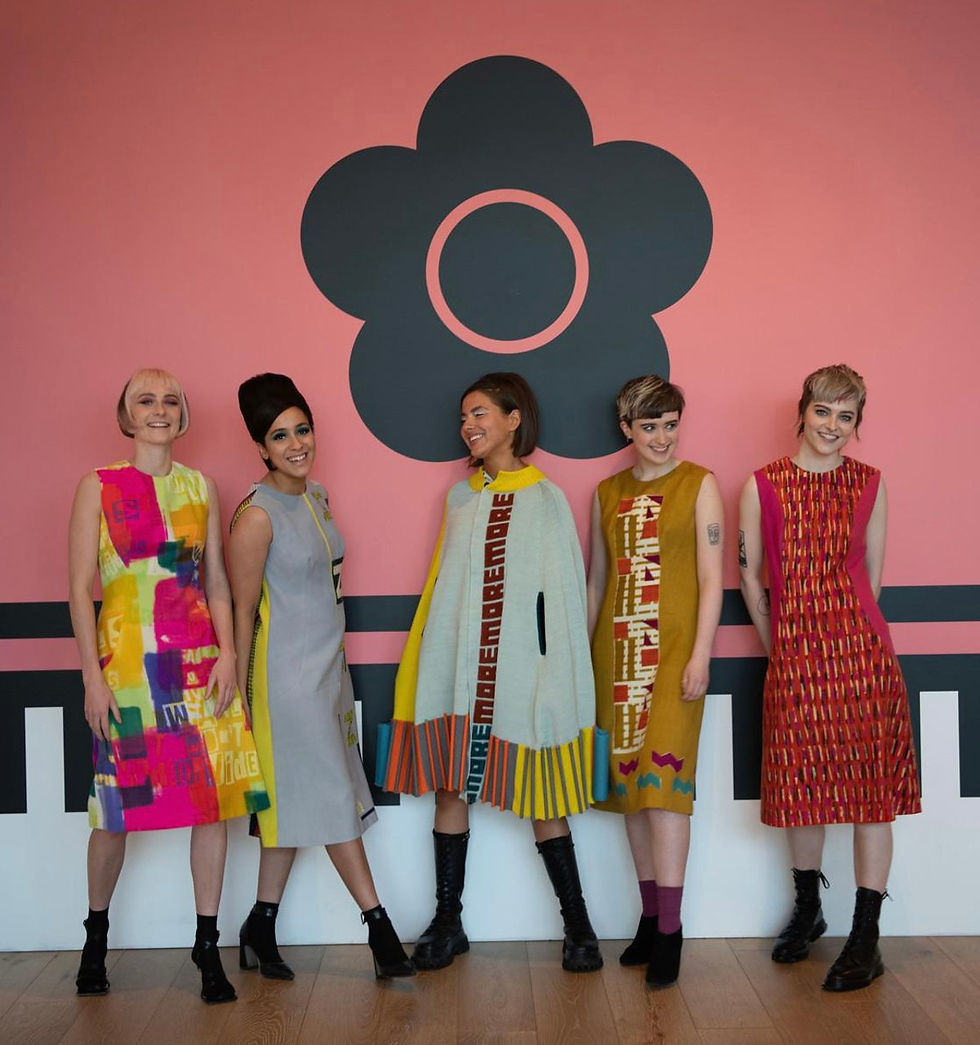Dame Mary Quant 1930-2023
- Emma

- Apr 16, 2023
- 4 min read

This week saw the passing of Dame Barbara Mary Quant - one of the most influential figures in the history of fashion and beauty. As one of my favourite fashion designers of all time, I wanted to pay tribute to this remarkable woman with a look at her incredible career
Mary Quant was born in London in 1930 and studied illustration at Goldsmiths College, part of the University of London. She began her fashion career designing clothes for herself and her friends, which she sold in a small boutique in Chelsea, London. Her designs were popular with young, fashion-conscious women who were looking for something new and exciting during this era of social and cultural revolution.
Quant's breakthrough moment came in the mid-1960s when she introduced the miniskirt. The mini skirt was a revolutionary garment that challenged traditional notions of femininity and sexuality. It was a short, straight skirt that barely covered the thighs and was often worn with coloured tights or stockings. The mini skirt quickly became a symbol of the youth culture that was emerging in Britain and around the world. Quant's design was also popular because it was practical; women could move freely in the short skirt, and it was easy to wear and care for.

Quant's success with the miniskirt led to a series of other groundbreaking designs. She also introduced hot pants, a super short pair of shorts, as well as the tunic dress, a short, loose-fitting dress that was often paired with leggings or tights. Quant's designs were often made from new materials such as PVC, and featured bold prints and bright colours. They were a departure from the more conservative fashion of the time, and were embraced by young women who were looking for something fun and exciting.
Quant's influence on fashion continued throughout the 1960s and into the 1970s. She introduced a line of cosmetics, and her designs were sold in department stores around the world. She also designed uniforms for flight attendants and other professionals, as well as a line of lingerie.

Quant's impact on fashion is still felt today. Her designs continue to be celebrated for their innovation and creativity. The miniskirt, in particular, remains an iconic garment that is still popular in 2023. Quant's legacy is also seen in the many designers who have been inspired by her work, including Jean Paul Gaultier, Vivienne Westwood, and Stella McCartney.
In addition to her contributions to fashion, Quant was also an important feminist figure. She believed that fashion should be fun and liberating, and that women should be able to express themselves through their clothing. She also believed that fashion should be accessible to all women, regardless of their income or social status. Quant's designs were affordable and accessible, and she often created clothes that could be worn by women of all ages and sizes.

Quant was also an important advocate for women's rights. She was a member of the Women's Liberation Movement, and she used her platform as a fashion designer to promote feminist ideals. She believed that women should be able to control their own bodies and their own lives, and she encouraged women to be independent and self-sufficient. Quant's fashion designs reflected these ideals, as they allowed women to be comfortable and free to move, while still looking stylish and fashionable.
Quant's impact on fashion was not limited to her designs, but also extended to her business practices. She was one of the first designers to adopt the concept of licensing, where a company would pay for the rights to use her name and designs on their products. This allowed Quant to expand her brand and make her designs more widely available. Today, licensing is a common practice in the fashion industry, and many designers have followed in Quant's footsteps.

In addition to licensing, Quant also played a role in the democratisation of fashion. Before her, high fashion was limited to a small, elite group of people who could afford it. Quant changed that by making her designs accessible and affordable. She was one of the first designers to create a line of clothing for a mass market, and she was also one of the first to collaborate with high street retailers. Today, fast fashion is a dominant force in the fashion industry, and Quant's contributions to making fashion accessible to everyone played a huge role in that.
Mary Quant also holds a place as a fashion icon herself. Her signature look, which included a short, mod-style haircut and bold makeup, inspired many people to emulate her style. She was often photographed wearing her own designs, which helped to popularise them - she could indeed have been one of the very first influencers! Her style was a reflection of the youth culture of the 1960s, which valued individuality and self-expression.

In conclusion, Mary Quant is an important figure in fashion history who revolutionized the way we think about fashion. Her innovative designs, business practices, and philosophy helped to shape the fashion industry as we know it today. Quant's impact on fashion is still felt, and her legacy continues to inspire designers, businesses and fashion enthusiasts around the world. She passes at the age of 93, leaving a timeless legacy behind her. Rest in Perfection.
Until next time
Emma x
Mary Quant, Mary Quant fashion, vintage Mary Quant, 60s Mary Quant, fashion history, vintage fashion history, 60s fashion history, fashion of the 1960s, iconic fashion designers, 60s fashion designers







Comments